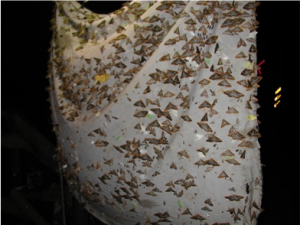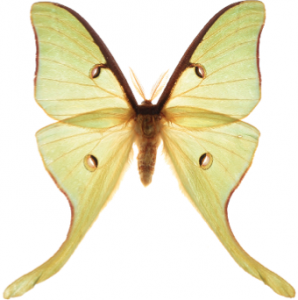By Joshua Epstein, Masters Student, Dept. of Wildlife Ecology & Conservation
Every evening when temperatures exceed 65 °F, thousands of bats can be seen swiftly emerging from the Bat Barn and Bat House on the University of Florida campus near Lake Alice. After a long day of rest, these flying mammals are ready to take on the night and fill their empty stomachs. As can often be seen when observing their departure from the bat houses, these creatures primarily consume small flying insects like mosquitos, beetles, and moths. To locate their prey, bats utilize echolocation, which is the generation of high-frequency calls that echo back to the bat after striking an object, allowing the bat to create a sonic map of its surroundings. Many species of bats are primarily insect eaters and moths are a favored type of prey. Moths therefore have a broad variety of defenses against these predatory bats.
Akito Kawahara, Assistant Professor and Curator at the McGuire Center for Lepidoptera and Biodiversity at the Florida Museum of Natural History, studies the diversity and evolution of butterflies and moths. Butterflies and moths are part of the taxonomic class Lepidoptera. Dr. Kawahara has conducted extensive research on how moths have evolved mechanisms to defend themselves against bat predation. He became particularly interested in researching moths because they have not been studied much. This is in part due to the difficulty of studying nocturnal creatures, such as moths and bats, which are difficult to study in the night sky.
Moths have evolved some truly fascinating defense mechanisms to protect themselves from becoming a late night snack. To study these mechanisms, Dr. Kawahara’s lab rears moths in captivity, and also collects wild moths by setting up a white sheet under ultraviolet light at night to attract them.

Some of the defense mechanisms that Dr. Kawahara’s lab has observed in moths include:
- Development of ears
- Ultrasound production
- Acoustic mimicry
- Jamming
- Tail structures
The first defense is the development of ears. Surprisingly, over 50,000 species of moths have developed ears on their bodies in response to bat predation. In fact, when you shake your keys, they emit sonar similar to that produced by bats. If you shake your keys in the presence of a flying moth with ears, the moth will dive to the ground to avoid encountering what it thinks is a bat.
Tiger moths, in addition to having ears to avoid bat predation, also have a structure that produces ultrasound providing this species another defense mechanism against bats. Tiger moths, whose responses to bat echolocation have been commonly studied, make similar sounds as bats. This behavior might seem counterintuitive because this noise may help bats find moths, but the explanation for this actually arises during the moth’s caterpillar stage. As caterpillars, tiger moths feed on toxic plants, and these toxins remain in their bodies when they become moths. Therefore, sound production is actually the moth’s message to predators saying, “You will get sick if you eat me!”
A third defense mechanism against predation also involves the toxicity of tiger moths. There are other edible or non-toxic tiger moths that acoustically mimic the sounds that toxic tiger moths make. Because bats already associate this noise with toxicity, these moths receive protection from bat predation without needing to be toxic.
Another type of moth that can detect and interfere with sound is the hawk moth, and they do so using structures on their mouthparts. By examining moth behavior in response to prerecorded bat attack calls, Dr. Kawahara and collaborators found that hawk moths also produce ultrasound, but they do so using their genitals. These moths produce ultrasound not to warn about or mimic toxicity, but to interfere with bat echolocation. This behavior is called jamming. As a bat approaches a hawk moth, the moth produces ultrasound, which hinders the bat’s use of sonar to locate the moth.

Dr. Kawahara studies another group of moths that do not use any of these bat predation defense mechanisms. These moths, called silk moths, have no ears, do not produce sound, and are not toxic. So how do these moths evade bat predation? Many of the silk moth species are large, and an original explanation was that their size inhibits consumption by bats. But aside from their large size, silk moths often have distinguished tail structures. These tail structures explain the final method of bat defense discussed. The luna moth, a species with tails, can actually be found here in Gainesville.
To figure out why these moths have tails, Dr. Kawahara explored why butterflies have tails. The tail structure of butterflies resembles a head and draws attention away from the body, which assists in the butterfly’s escape from predation. However, moth tail structures do not resemble a head. To explore this further, Dr. Kawahara and his lab reared hundreds of luna moths in the lab and examined their flight behavior. They noticed that the tails lag behind the wings when the moths are flying. Dr. Kawahara and collaborator Dr. Jesse Barber also discovered that the capture rates by bats on tailed moths and moths with removed tails were 30 percent and 80 percent, respectively. Through these studies, the researchers concluded that these moths’ tails are associated with increased survival because they confuse bat sonar, and attract attention away from the moths’ body.
Dr. Kawahara believes that the continued understanding of moth shape, structure, and tail length will give additional insight to both when and how these mechanisms evolved. The next time you are eagerly waiting for the first few bats to emerge from the UF Bat House and Bat Barn, remember there is more going on in the sky than meets the eye… or ear.
 0
0
